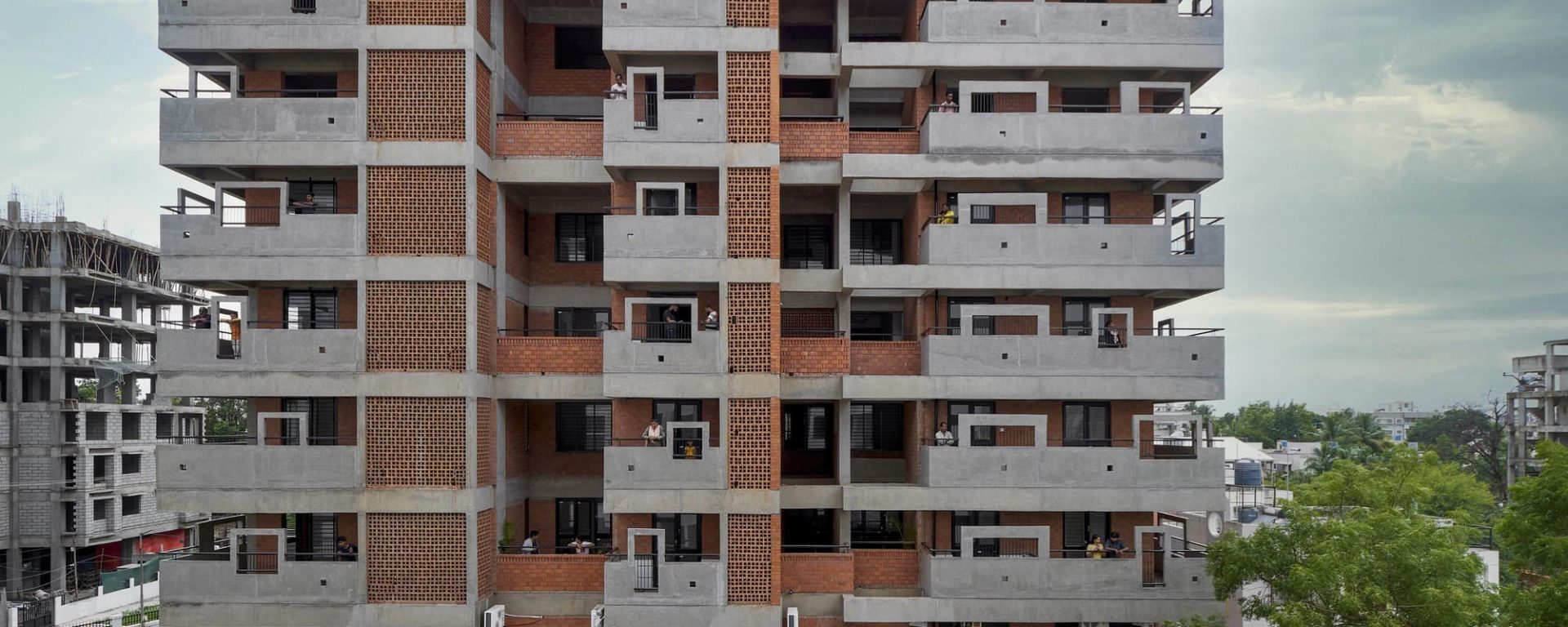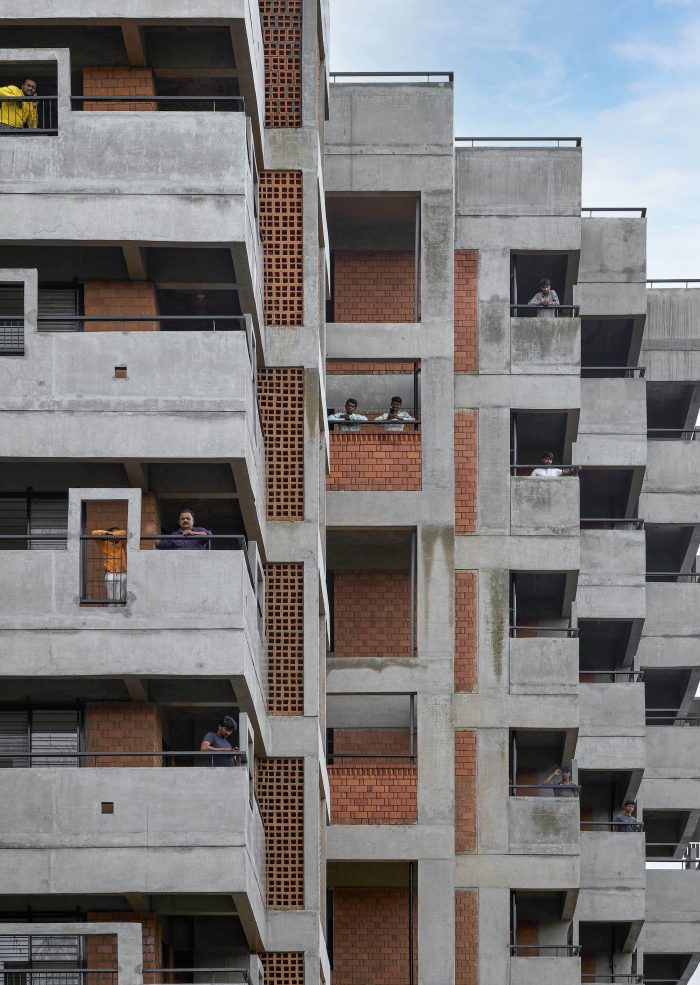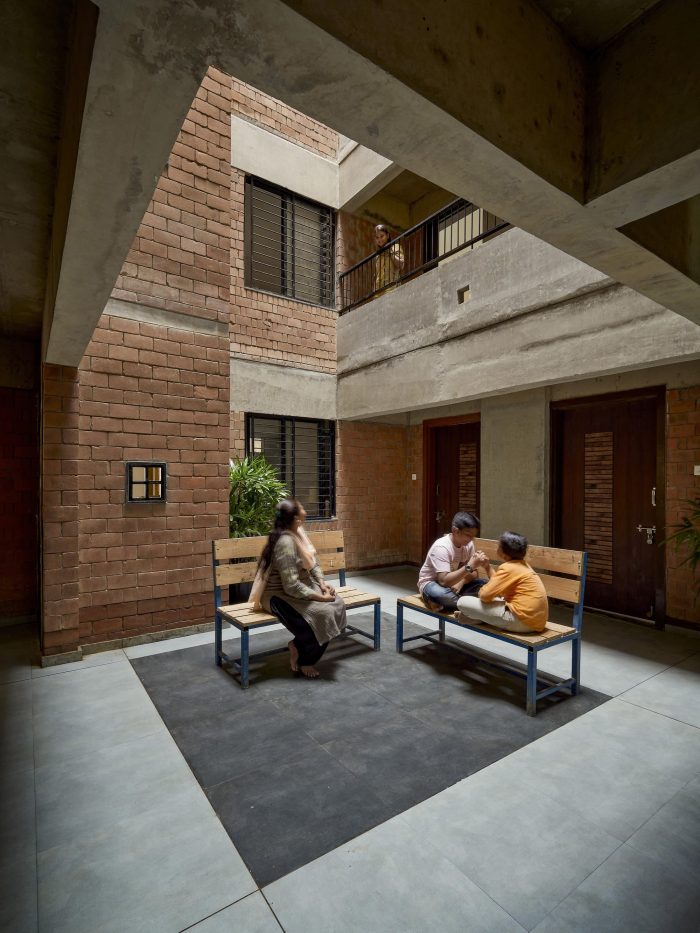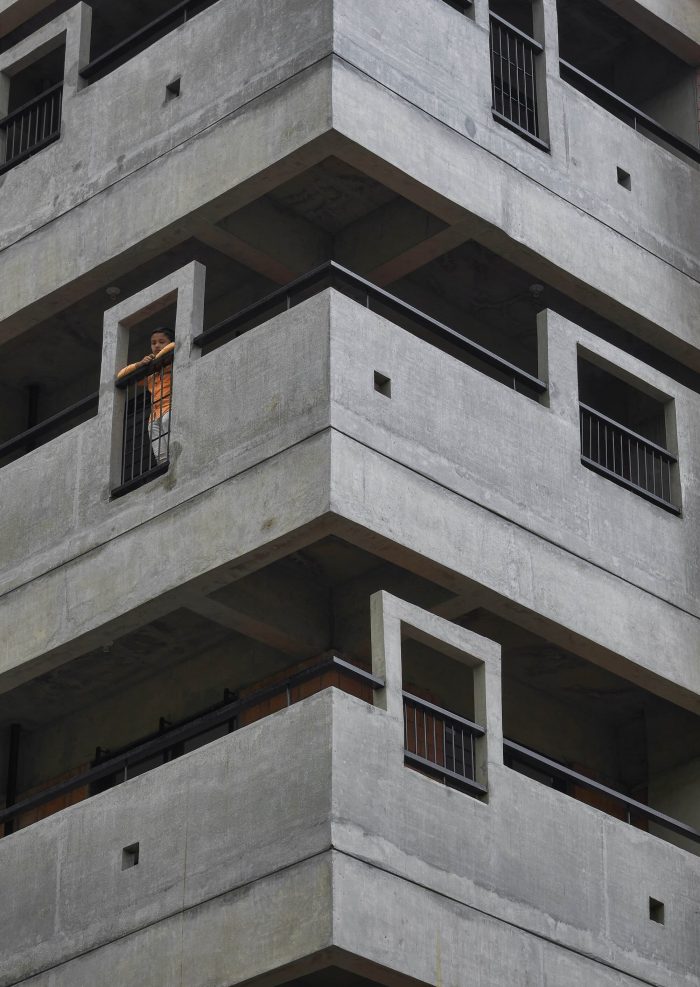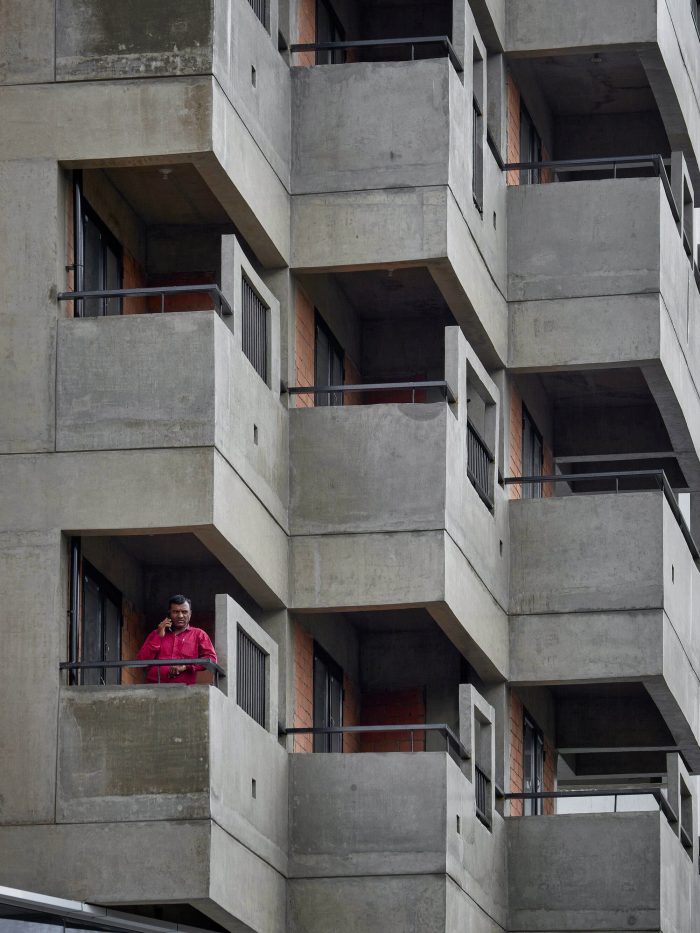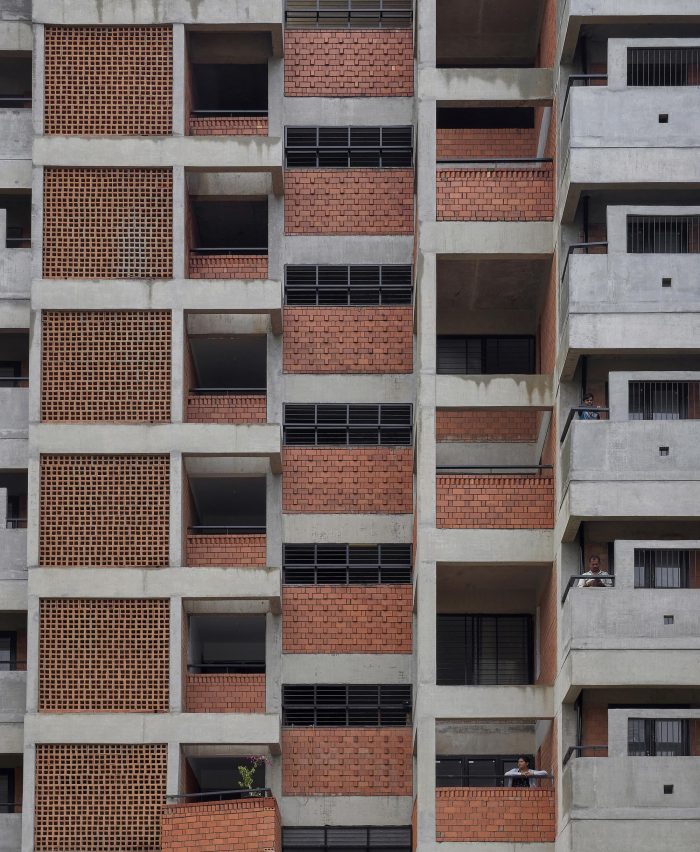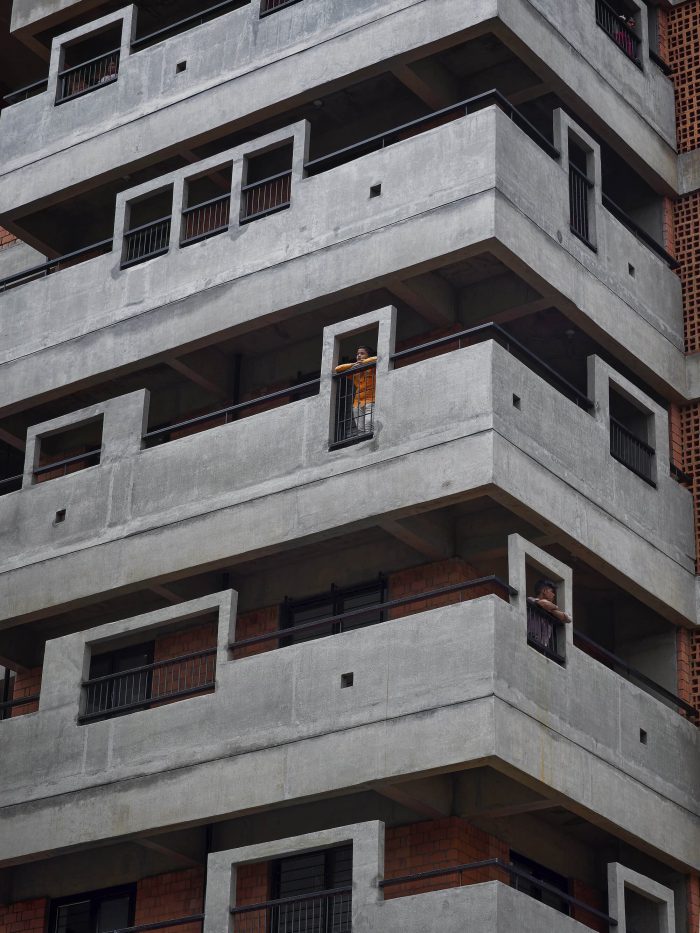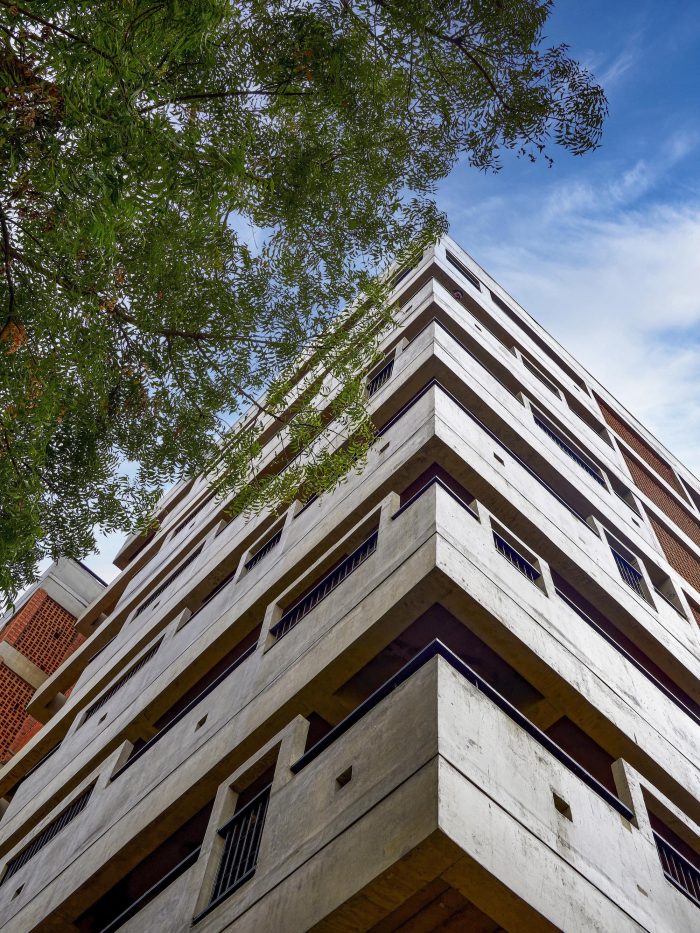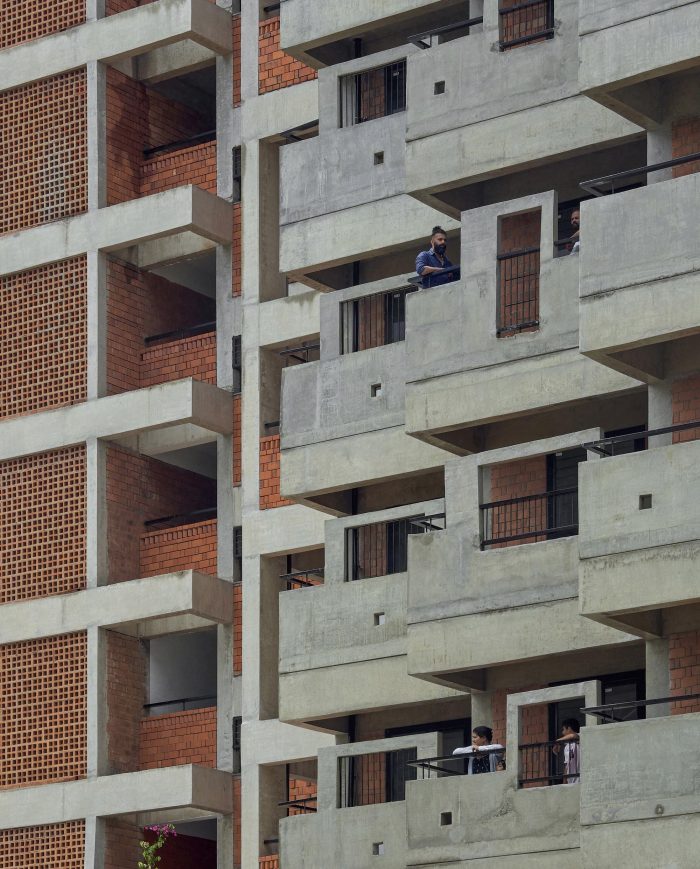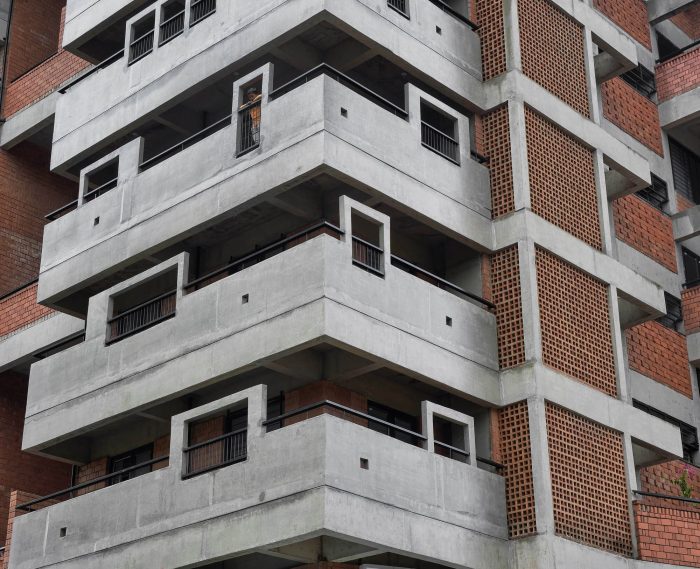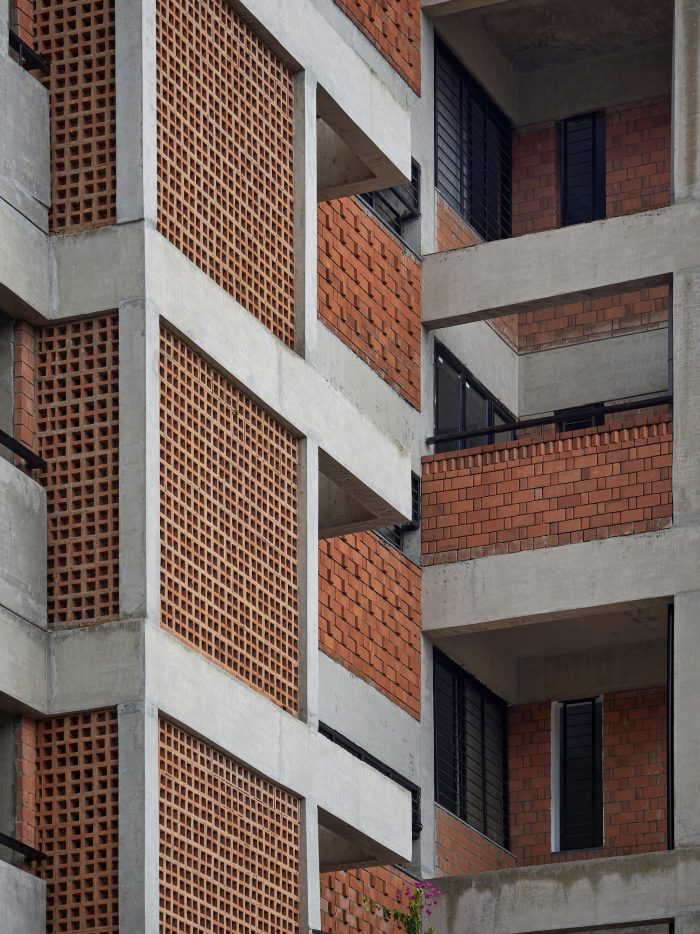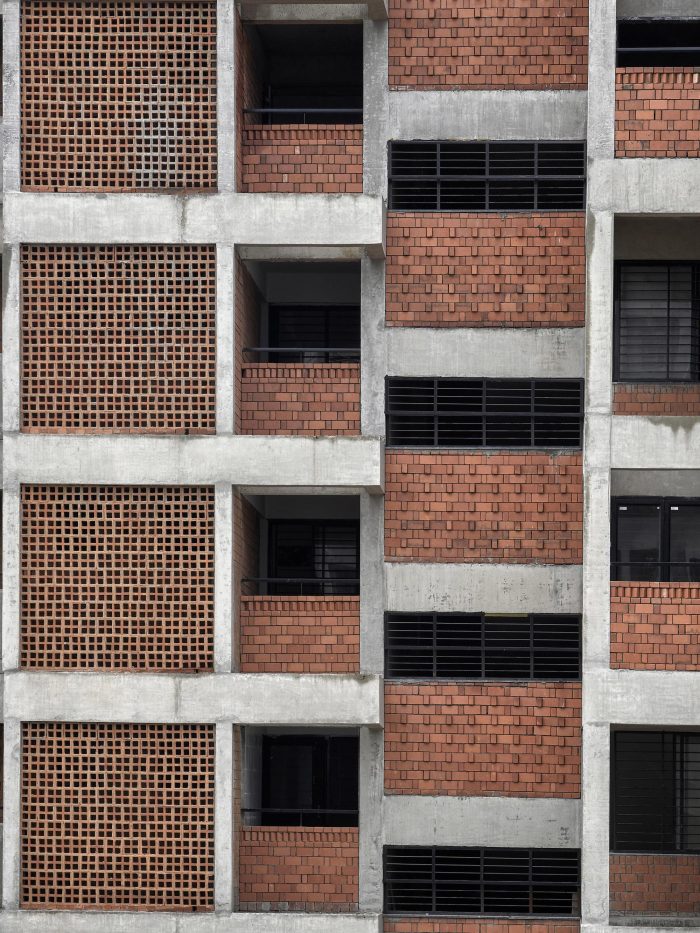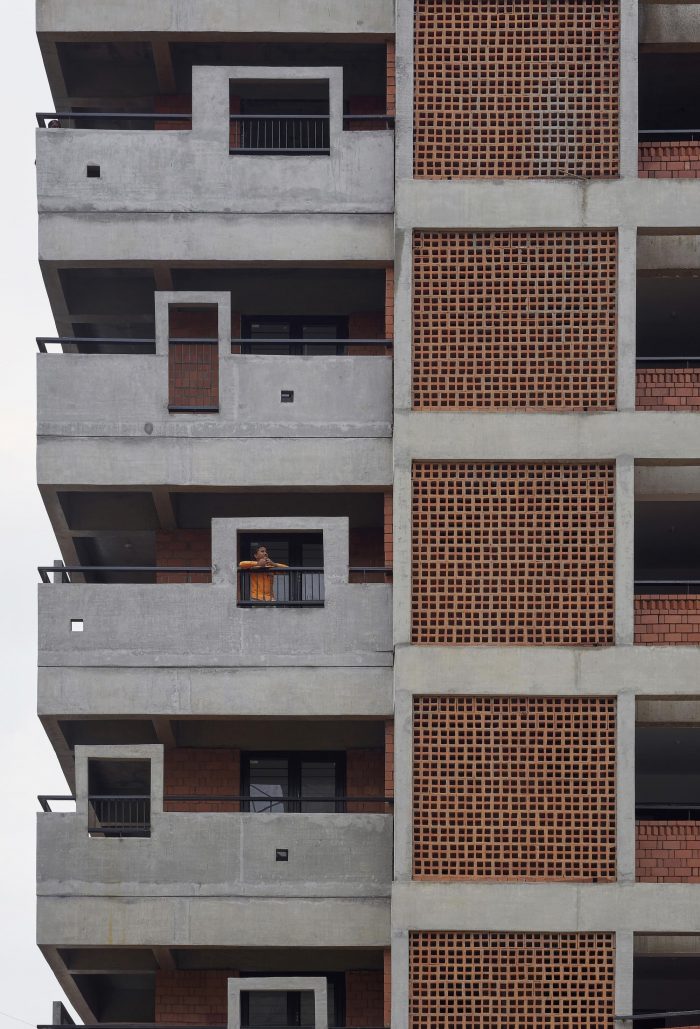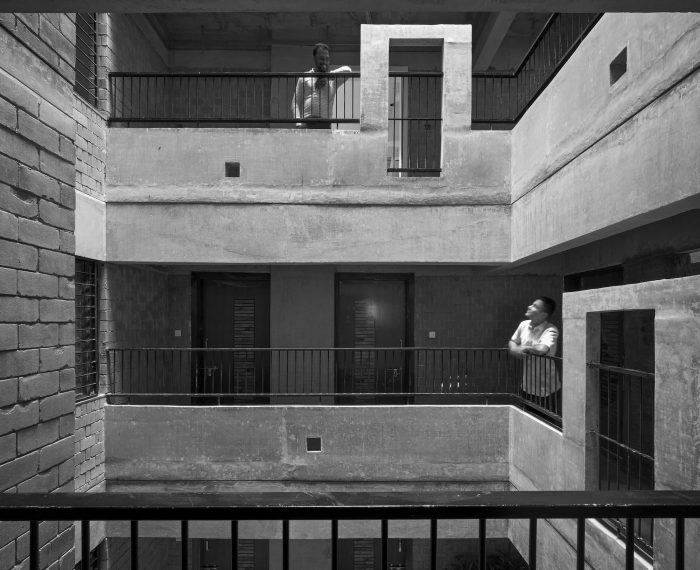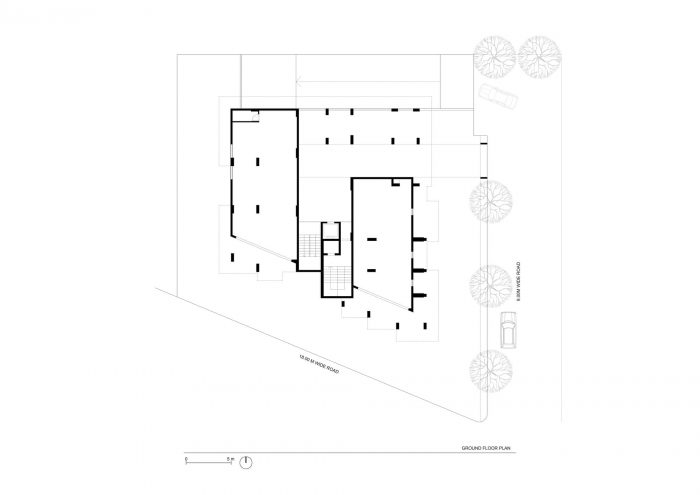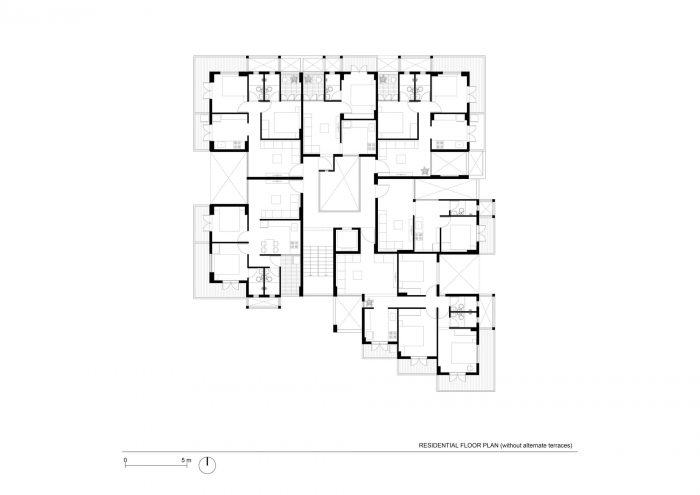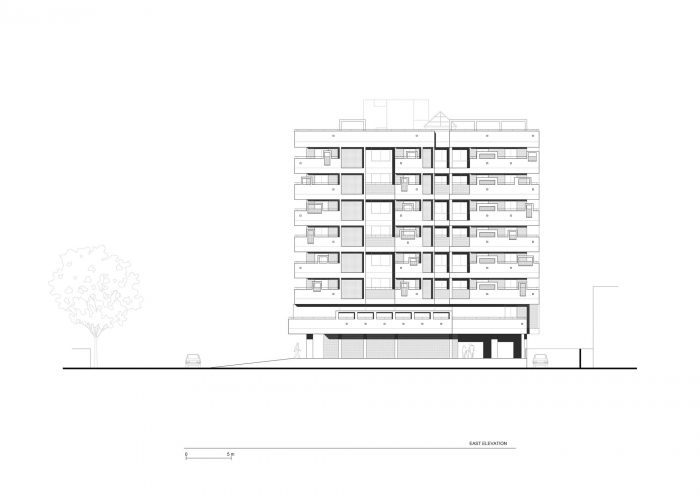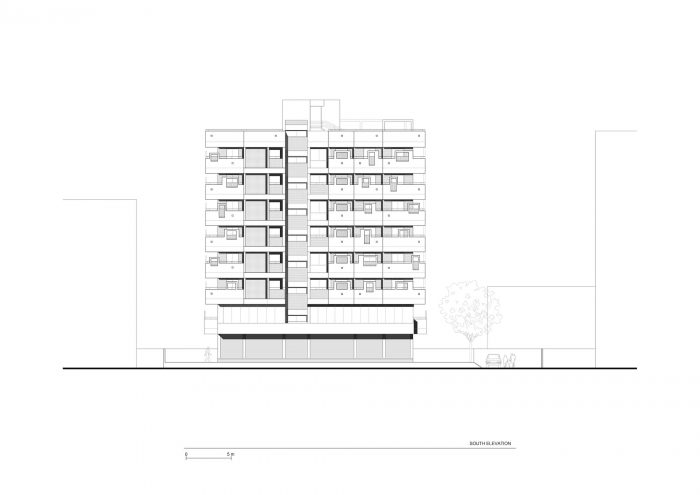背景和设计简介 – 最初,这块拟议的土地(地块)将有一个大约10至11层的塔楼,每层有4个中型住宅单位,地面上有一些商业区。不知何故,这个想法被搁置了,愿意承担这个项目的开发商之一,Naresh Bhadakwade先生,来询问另一个解决方案,它将是 “美学上不同的”(?),可持续的,与先前的方案相比稍微低一些,但仍然消耗类似的FSI,以保持该方案的商业可行性。
Background and Design Brief – Initially, this proposed land (plot) was going to have an approx. 10-to-11-story tower with 4 mid-size residential units per floor and some commercial area on the ground. Somehow that idea got stalled and one of the developers who were willing to undertake the project, Mr. Naresh Bhadakwade, came to ask for an alternative solution that would be ‘Aesthetically different’ (?), Sustainable, slightly low rise as compared to the earlier one, but still consuming the similar FSI to keep the proposal commercially viable. with these inputs, the design process started…
建筑规划–与之前每层4个相同单元的想法相比,我们同意在一层有6个单元的设计,而且有不同的尺寸和方向。这意味着,一般来说,在印度的住宅公寓楼中,都会有一个简单的镜像式的对称性,因为那里的客户群大多是类似的。这意味着,一个三居室单位(3BHK)的建筑一般不提供一居室(1 BHK)类型的住宅,反之亦然。这种现象有助于通过建筑促进不公平的社会划分(孤立的社区)。 我们试图挑战这种观念,并试图在一个单一的楼层提供所有三种一般的尺寸类型–一室公寓、两室公寓和三室公寓。在这里,我们的目的是为客户提供一个建筑环境,在这里,唐楼的尺寸和它们各自的价格是不同的,但其居民的社会地位、快乐和自豪的感觉是相同的。这一决定不仅给建筑规划带来了更多的包容性,而且也证明了在利用该地块的全部建筑潜力方面是有效的,特别是考虑到其特殊的棱角形状。
Architectural Planning – Compared to the previous idea of 4 identical Tenements per floor, we agreed upon a design having 6 tenements on one floor, that too with a variety of sizes and orientations. This means, generally a simple Mirror-type of symmetry is found in Residential Apartment buildings in India where mostly a similar kind of customer base is focused upon. Meaning, a three-bedroom units (3BHK) building may not generally offer one-bedroom (1 BHK) type of tenements and vise-versa. This phenomenon helps promote an unfair social division through architecture (isolated neighborhoods). We tried to challenge this conception and tried to offer all three general types of sizes on one single floor – a one-bedroom tenement, two bedrooms tenement, and a three-bedroom tenement too. Here the intention was to offer the customers a built environment where the tenement sizes and their respective pricing would be different, but the social status and the feeling of joy and proud ownership would be the same among its inhabitants. This decision not only gave a more inclusive character to the architectural planning but also proved to be efficient in terms of the utilization of the full built-up potential of the plot, especially considering its peculiar angular shape.
重新思考住房的可持续性和材料性–一旦规划和结构网格得到确认,就需要努力寻找美学语言,使其在视觉吸引力(考虑到当地环境)、材料性和施工方法上具有新鲜感。我们当然知道我们不想要什么–玻璃栏杆、合成材料覆盖物、逐层 “复制粘贴 “的外观等….,而不是所有这些,我们的努力是在建筑的外部外观中突出楼层规划的折衷特性,大胆地表达裸露的RCC框架结构,并通过新鲜的视觉构成揭示砖块和成型混凝土的微妙美和审美潜力。
Rethinking the Sustainability and Materiality in housing – Once the planning and structural grid got confirmed, there was an effort to search for the Aesthetic language that would be something fresh in its visual appeal (considering the local context), in its materiality, and construction methodology. We were certainly on what we don’t want – glass railings, synthetic material claddings, floor-to-floor ‘copy-paste’ looks, etc.…instead of all this, our effort was to highlight the eclectic character of the floorplan in the building’s external appearance also, boldly expressing the bare RCC frame structure, and unveiling the subtle beauty and aesthetic potential of the bricks and form-finish concrete through a fresh Visual Composition.
在印度的住宅建筑中,一般来说,我们创建一个RCC结构,用砖砌成内墙,然后用石膏覆盖,再涂上油漆。这种 “标准化的做法 “是我们辩论的主题,使我们倾向于使RCC框架和砖墙不仅发挥结构作用,而且同时发挥美学作用的想法。在我们的国家马哈拉施特拉邦,我们所有的山地堡垒都是用玄武岩石头或传统的 “WADAs”(房屋)建造的,用红砖/石头来描述这种结构美学和材料美学的融合,自古以来都是如此美丽和可持续;在这里,建筑过程和它的审美结果成为一种同步的现象。这是一个固有的可持续发展的想法,因为我们在应用和完善合成材料和表面的过程中节省了大量的体现能源和过程。减少这种(不必要的)过程和材料,并使用户的眼睛熟悉这种原始的、裸露的、较少加工的 “美学”,肯定会被认为是未来建筑的一个有洞察力的可持续发展方法。就像高度加工的食物对人体有害一样,我们对这种以建筑之美和现代性为名的高度加工和人工表面和材料的视觉迷恋和认可,从长远来看,可能不是一种可持续的方法。(这虽然是个人的观察,但我真诚地认为有必要提及。)
In Residential Buildings in India, generally, we create an RCC structure, build internal walls with bricks and then cover it all with plaster, and then apply paint. This ‘standardized practice’ was our topic of debate and made us inclined towards the idea of making the RCC frame and brick walls play not just a structural role but also an aesthetical role simultaneously. In our state- Maharashtra- all our mountain forts are made in Basalt stone or traditional ‘WADAs’ (Houses) built in red bricks/stone used to depict this amalgamation of Aesthetics of The Structure and Aesthetics of the Material so beautifully and sustainably since ages; here, the construction process and its aesthetic outcome becomes a simultaneous phenomenon. This is an inherently sustainable thought as we save a lot on the embodied energy and process required for the application and refinement of synthetic materials and surfaces. cutting down on such (unnecessary?) processes and materials, and acquainting the user’s eye for such raw, bare, less processed ‘aesthetics’ would certainly be considered as an insightful sustainable approach towards architecture in the future. Just the way High-Processed Food is Harmful to the Human Body, our Visual obsession and approval for such High processed and Artificial Surfaces and materials in the name of Architectural Beauty and modernity might not be considered a Sustainable approach, in the long term. (This, although a personal Observation, one sincerely felt the need to mention it.)
回到这个项目,对于材料的选择,少即是多是我们的座右铭。空心砖砌体的使用既是为了其美观的外观,也是为了其良好的绝缘质量。第二个重要的因素是使用模板处理的混凝土。除了这两种材料–混凝土和砖–外围的阳台和双层露台也发挥了同样重要的功能和美学作用。栏杆墙被设想为不仅是一个安全屏障,而且是一个 “画布”,通过视觉上精致的混凝土框架的众多组合,提供各种观点和暂停点。贯穿这些框架和护墙的顶部的M.S.栏杆管是观察眼睛的水平常量。它是一种眼睛的稳定器,纠正和平衡这两种材料的粗糙和不完美。
Coming back to the project, For the material pallet, less is more was our motto. The cavity brick masonry was used both for its aesthetic appearance and its good insulation quality. The second important element was the use of form-finish concrete. Along with these two materials- concrete and brick- The peripheral balconies and double-height terraces are also playing an equally important functional and aesthetical role. The parapet wall is conceived not just as a safety barrier but as a ‘canvas’ that would offer a variety of views and pause points through numerous combinations of visually delicate concrete frames. The M.S. railing pipe on top that runs through these frames and parapet walls is the level constant for the viewing eye. It’s a kind of eye stabilizer that corrects and balances the rawness and imperfections of these two materials.
从地板上看,混凝土框架的组合没有重复。这种混乱(随机)秩序的 “美学”(就像印度老市场的传统街道–“集市”)使建筑立面在视觉上吸引了观众的眼球,让人好奇。当居民在这些空间里生活时,外墙就会成为通过街道观察他们生活的 “活屏幕”。这个项目,从规划到实现,是一个漫长的努力、坎坷、错误和教训的旅程。该项目还见证了 “伟大的 “电晕大流行及其带来的封锁。坦率地说,考虑到当地的环境、市场的审美情趣和资金的限制,这是一个实验性的雄心,但也是一个真诚、谦逊和好奇的尝试,为印度的住宅公寓呈现出不同的视觉形象。这个项目的核心理念和图像包含了对过去的一些参考,但它试图用现代建筑语言来表达这些。
Floor-wise, there are no repeat sets of combinations of the concrete frames. This ‘Aesthetics’ of chaotic (Random) order’ (like the heritage Streets of the old markets- ‘Bazaars’ in India) makes the building façade Visually engaging and curious to the viewer’s eye. When the residents would be living their lives in those spaces, the façade would then become a ‘live screen’ of their life observed through the street. This project, right from the planning to its realization, was a long journey of efforts, ups, and downs, errors, and lessons learned. The construction has also witnessed the ‘great’ corona pandemic and its consequential lockdowns. Frankly speaking, considering the local context, the Market’s aesthetical taste, and its financial limitations, this was experimentally ambitious, but yes, a sincere, humble, and curious attempt to present a different visual portrait of a Residential housing Apartment in India. the core idea and imagery of this project contain some references to the past, but it tries to express those in a contemporary Architectural Language.
Architects: Studio Frozen Music
Area : 53000 ft²
Year : 2022
Photographs :Hemant Patil
Manufacturers : Apollo Steel, Dirk India Pvt Ltd, Essco by Jaquar Group, Infinity French Doors, Jaquar, Johnson Lifts, Kitec, Legrand, Mangalore, Polycab, Prism Johnson Limited
Lead Architect : Mahesh Deepak Shirke
Structural Design : Reliable Consultants, Sanjeev Patel Sir
Municipal Licensing : Gaikwad Associates
Qc Consultant : Amol Rahade
Rcc Contractor : Vijay Sonavane, Ravi Jagtap
Site Supervision : Sunil Ughade, Neeraj Naik, Rupesh Namphalle
Rcc Surface Rendering Work : Udaybhan Yadav
Plot Owner : Avinash Tile, Ashok Tile
Developers : Sakshi developers, Rahade & Naresh Bhadakwade
City : Nashik
Country : India

